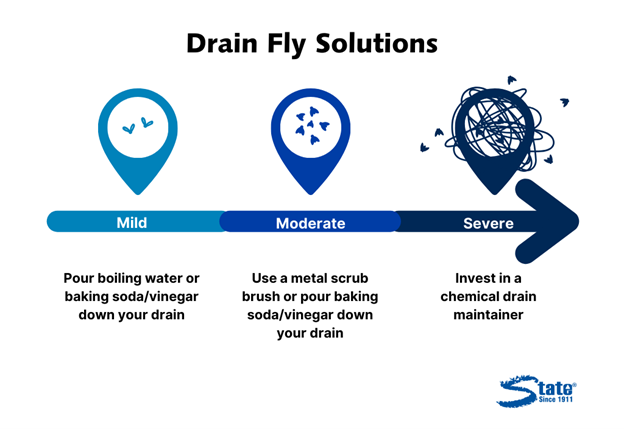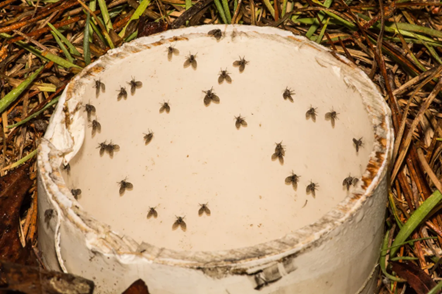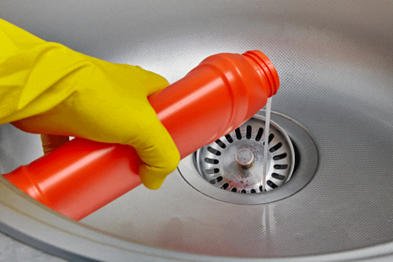How to Get Rid of Drain Flies
How to Get Rid of Drain Flies
Picture this: you’re the manager of a food processing plant. Lately, gnats seem to be spawning all over the plant—on the walls, the floors, the drains, the processing equipment itself. Every day, you hear more worker complaints, and you’re growing increasingly worried about health inspections. You’ve tried insecticides to no avail; how do you eliminate these pests?
At State Chemical, we sell chemical solutions to hundreds of problems, including NO Contest, which eliminates drain fly habitats. We understand that when dealing with a problem, you want the quickest and most effective solution without any hassle.
To help you with your drain fly problem, we will explain what drain flies are, what a problem can look like, what negative consequences you may face, and how to eliminate drain flies. After reading, you’ll know how to keep your facility clean and pest-free.
What are Drain Flies?
In order to understand how to eliminate drain flies, you first must understand what a drain fly is.
To the blind eye, drain flies look like gnats or fruit flies. However, if you look more closely, such as under a magnifying glass, you’ll see that drain flies are more like a cross between a housefly and a moth. They’re fuzzy with bigger wings and will never venture far from your drains.
So, why is this? Drain flies thrive in drains because of the fats, oils, and greases (FOGs) that go down every drain. In a facility like a food processing plant, food scraps and FOGs constantly go into the drain, building up and clinging to the sides of the pipes over time.
The drain flies then use this buildup as a food source, breeding ground, and habitat all in one. As long as there are FOGs in the drain, drain flies will continue multiplying and invading the facility.
Meanwhile, fruit flies will feed on fruit, and gnats are more attracted to the organics in soil. If the flies in question in your facility seem to be attracted to areas other than drains, you are not experiencing a drain fly problem.
What Does a Drain Fly Problem Look Like?
When you have a drain fly problem, the issue probably isn’t immediately obvious to start. At first, you might only notice a few buzzing around. But once they’ve been given the chance, drain flies will reproduce, and their presence will be more obvious.
Once this happens, you’ll see drain flies on surfaces around your drains. In a kitchen, this might be sinks, walls, and shelving. Drain flies actually aren’t great at flying, so you’ll mostly notice them lounging around. If you look down into your drains, you might even be able to see the larvae wriggling in the water.
Negative Impact of Drain Flies
Obviously, drain flies are gross, but what adverse effects might they have on your facility?
The most glaring problem that drain flies may cause you is a health code violation. Drain flies are not known to cause diseases to humans, but they are known to trigger allergic and asthmatic reactions because of the dust and fragments from their bodies. Additionally, they can carry bacteria from your drain into other areas of your facility. They live in filth, so the filth they gather is easy for them to track around, making them a red flag for health departments.
However, aside from just the health department repercussions, these pests can cause harm to your staff and customers with these possibilities. When there’s a chance for allergic and asthmatic reactions and drain flies carrying pathogens, the way to keep users of your facility safe is by treating the issue.
Plus, if customers see drain flies in your facility, it will be a big turnoff, and they’ll be less likely to visit your facility again. Similarly, with an annoying and nasty pest invasion, employees will be less likely to view your workplace as a safe, happy, and healthy environment.
How to Get Rid of Drain Flies
Drain flies aren’t something you want to welcome into your facility, so how should you get rid of them? The only way to deter drain flies from your facility is to eliminate their habitat. You can swat at individual flies to control the problem, but to get to the root of the issue, habitat elimination is your only option.
Depending on the severity of your issue, you can do this in a few ways:
Pour Boiling Water Down the Drain
For minor infestations (e.g., you’ve only noticed a few drain flies), pouring boiling water down the sink may be an effective solution for you. This works by temporarily melting the FOG buildup that the drain flies live in and moving it down the drain line.
However, if your issue is moderate or severe, this is not the solution for you. More significant drain fly problems indicate more buildup, so if their habitats stretch further down the drain line, boiling water won’t help. It will only treat the top of the drain, and the drain flies will have no trouble rebuilding from the bottom.
Pour Vinegar and Baking Soda Down the Drain
Another solution to more minor infestations is to pour one cup of vinegar with a half cup of baking soda down your drain. This will clear out the buildup in your drains, eliminating drain fly habitats.
However, it still does not get to the root of bigger problems. As the solution carries down your sink, it will become diluted and will not as effectively clean buildup further down the line. Again, this is not ideal for bigger issues.
Use a Metal Scrub Brush
This is a great solution for moderate issues. As far down as your metal scrub brush will reach, you can scrub FOG buildup off the inside walls of your pipes, taking out drain fly habitats firsthand.
If your issue is severe, this solution won’t work because you’ll be dealing with so much buildup that spans so far down the pipes. But for standard buildup, this is an effective way to ensure the removal of drain fly habitats.
Pour a Chemical Drain Maintainer Down the Drain
For moderate and severe issues, you should use a chemical drain maintainer specifically designed to eliminate drain fly habitats. Drain maintainers work by clearing FOG buildup through your pipes either through emulsification or bacteria. This removes the drain flies’ habitat, food source, and breeding grounds all in one, and it works all the way down the line from where it enters.
This action is not usually necessary with minor drain fly problems. However, chemical maintenance gets to the root of the problem and prevents future buildup that could attract drain flies later. In this way, it can also be used as preventative maintenance even after you get rid of drain flies in your facility.
Find Your Solution to Drain Flies
When your facility is faced with a drain fly infestation, it’s stressful, gross, and overall unpleasant. Now that you know what solutions are best for your problem’s severity, consider exploring solutions to common concerns about preventative drain cleaners.












